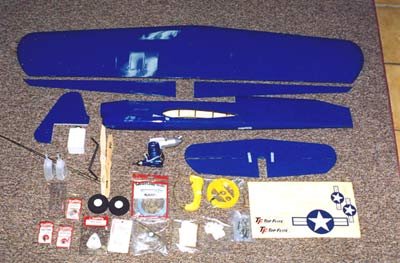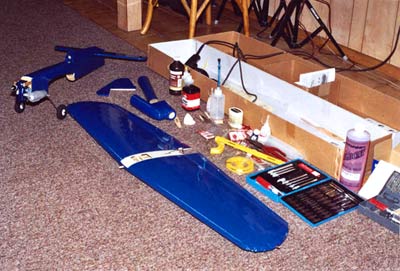 |
| CONTROL LINE FLYING |
| Flying a control line model is one of the most exciting
and fun things a modeler can do. Yes, the procedure is over 50 years old,
but I believe that anyone who tries it will be hooked for good. There is
absolutely nothing like inverted flight, reverse wingovers, outside loops,
horizontal eights, and the many other maneuvers that are not only thrilling
to perform but great for the spectators. Just set up a 60 foot circle and
start flying a model and you will immediately see a crowd form, enjoying
your model's performance. It really is that interesting. I am building an
RC model for this website, and find that it requires a few bucks to get
into that type of flying. Control line flying is relatively inexpensive,
and the excitement and satisfaction of a successfully completed flight is
hard to beat. |
 |
| WHAT MODEL TO SELECT |
| So I decided to build a CL model, hoping that maybe a few
of you will give it a try. I selected the TOP FLIGHT CL NOBLER. This plane
goes back to the 1950's, and is recognized as one of the most popular and
successful CL stunt models of all time. Reincarnated from original TOP FLIGHT
plans, the NOBLER is a perfect way to get into beginner stunt flying without
the initial time and money required for today's kit-built stunters. The
NOBLER has the perfect blend of maneuverability and stability to get you
in the air and give you a great performance. If you are interested in this
model you can find it at Tower Hobbies, www.towerhobbies.com. Search for
TOP FLIGHT or just put in NOBLER. You will find that Tower has the absolute
largest selection of models and accessories and has the easiest site to
navigate. VERY professionally done. The accessory and parts list is humongous.
The NOBLER has a 50.5 inch wingspan. Recommended engine size is .35 to.46
two stroke glow. I selected the O.S. 40 in blue with muffler. O.S. in the
past has given me great performance and dependability. For a flawless performance
I recommend it. The O.S. 40 LA-S offers the proven power of the LA series
R/C Sport engines- but is engineered for the special requirements of control
line flying, replacing the carburetor with a venturi that keeps the engine
running at a constant speed. A remotely mounted needle valve keeps your
hands safely distanced from the spinning prop during adjustments. An O-ring
helps seal the needle against fuel and air leaks. I will use .018 X 60'
multi-strand lines. I bought the ARF version of the NOBLER which comes factory
covered in TOP FLIGHT MONOKOTE sapphire blue film. Workmanship is superior.
This plane has wing flaps which work in opposite direction to the horizontal
stabilizer elevators. I found the instructions to be very complete and easy
to understand. The completed model is a real beauty. |
 |
| PERSONAL MODIFICATIONS |
| I guess everyone has his own ideas on personal changes
to a model he is building. I have a few things that I do that work for me.
Be warned that you may not agree, if so please do not use them. I always
mount the engine at a VERY SLIGHT angle facing the outside of the circle.
I want to feel the lines tight. I won't forget flying one of my first CL
models that took off leaving me with NO tension on the lines. The plane
turned and headed straight for me. I tried to run but in a second it hit
me in the rear end, to the laughter and never ending remarks about this
fiasco. Now, on a combat plane I make the left wing slightly longer than
the right one. I add weight where needed to the right wing. I angle the
rudder slightly to the right, and on take off I have the person holding
the model launch it slightly to the outside of the circle. Upon launch I
immediately take a step back until I determine that I have the proper pull.
Yes, I make sure I have TENSION. |
 |
| SAFETY PRECAUTIONS |
- Always inspect your equipment before each flight. Make
certain your lines, leadouts and handle are in good condition. Make
sure there are no kinks in the lines.
- Fly only in unobstructed areas free from trees, bushes,
poles, stakes, parking barriers and fences.
- Be aware of any spectators that may wander into the
flying circle. If this is a possibility, have your assistant ready to
perform crowd control.
- The model must NEVER be flown in the vicinity of high-tension
lines or any other electrical lines.
- Never fly when thunderstorms or lightning are present.
- Take precautions necessary to insure the safety of
spectators, the model, and property.
- Never touch the engine during or soon after operation.
- Keep clear of the rotating prop and do not let assistants
or
spectators get near the arc of the prop.
Make sure you have double checked everything before take
off. Keep your lines tight, and have a great flight with your new NOBLER.
All remarks are considered personal opinion of Wayland
Mayo.
|
|
|


